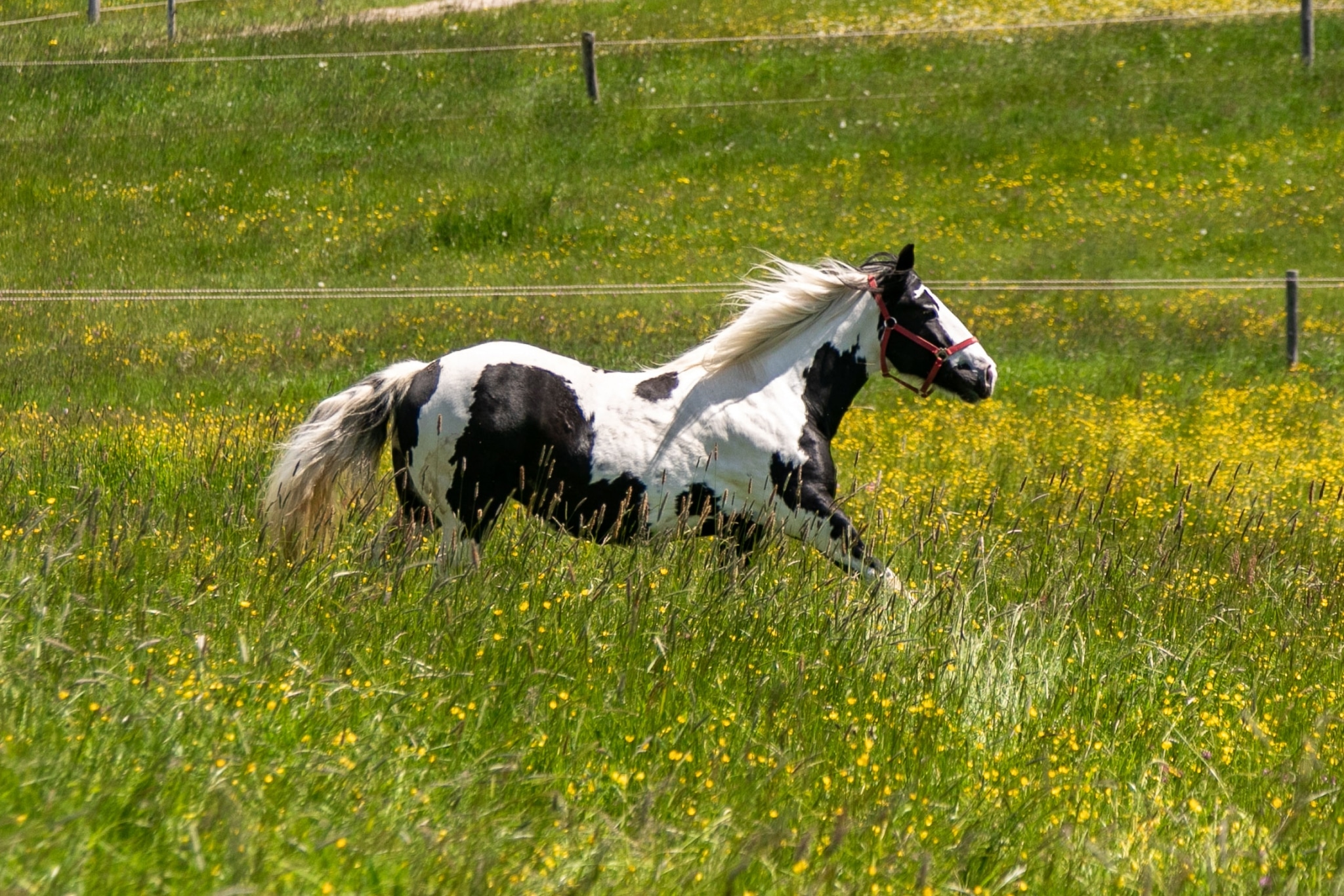
Horse health
In order to understand the needs of ageing or chronically ill animals and enable them to enjoy a better quality of life, it is necessary to take a closer look at equine health. In combination with modern and alternative treatment methods, physical and physiological health factors are observed in old horses. The quality of life of rescued horses at Gut Aiderbichl can thus be ensured in the long term.
The population of older horses is growing worldwide. However, ageing is associated with physical and physiological changes. The development of the microbiota that inhabits the hindgut during this ageing process is still poorly understood. As this microbiota plays an essential role in the digestion of fibres, the support of metabolism and an adapted immunity, it is necessary to maintain a „healthy microbiota“.
The aim of the „Healthy Ageing“ project is to increase knowledge about the senescence of the equine intestinal microbiota and the associated digestive, metabolic and immune functions. The knowledge gained should make it possible to develop recommendations, in particular nutritional recommendations, for maintaining the health and well-being of horses in old age.
Effects of ageing on the hindgut flora of horses
Understanding the effects of ageing on the faecal microbial ecosystem to promote healthy ageing in horses
Basis/starting point: The horse’s large intestine harbours millions of different microorganisms that play an essential role in digestion and energy supply. Under the influence of environmental or intrinsic factors, changes can occur in the microbiota of the large intestine that can worsen the health and/or well-being of the horse. One of these factors is ageing, and its effects on the microbiota are still poorly understood. Little existing information reports a decrease in bacterial diversity in horses with age, which is indeed consistent with data in humans. Such a decrease may lead to a reduced resilience of the microbial ecosystem to environmental stresses. In addition, too little information is known about the evolution of the efficiency of crude fibre digestion in horses with age, which is crucial for energy supply, digestive health and consequently the overall health of the animal.
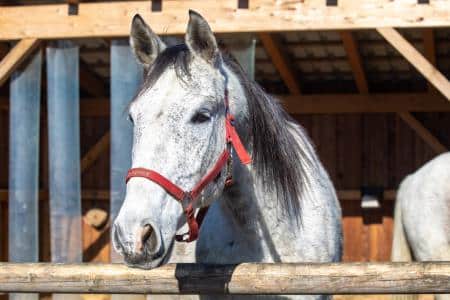
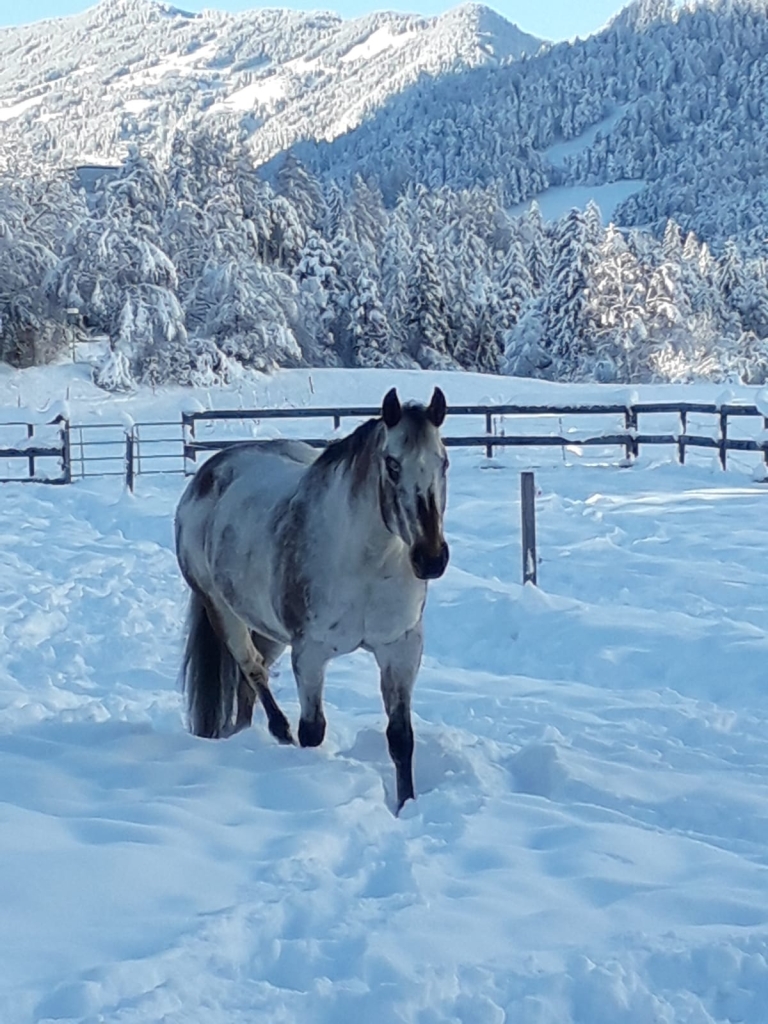
Aim: The aim of the project was to investigate the changes in the faecal microbiota that occur with age in horses. This led to: (1) the investigation of the age-related development of the bacterial composition of the faecal microbiota and (2) the evaluation of the effects of these changes on digestion. To answer these questions, 50 horses aged between 6 and 30 years were monitored under the same feeding regime and faecal samples were collected and analysed.
New findings: Different faecal parameters indicating bacterial activity were influenced by age, with differences between older horses (≥26 years old) and younger horses increasing steadily and being highest. These results indicate high-level age-related changes in digestion, possibly caused by composition and/or activity changes in the microbiota. The bacterial structure in the faecal ecosystem – currently under investigation – will provide additional information to understand the digestive development of the horse’s colon with increasing age.
Outlook: The results on changes in the faecal bacterial microbiota with age will help to suggest management recommendations for horses adapted to their age, in particular feeding adjustments. The observed changes in the faecal microbiota open up perspectives for understanding the causes of microbiota-mediated diseases in older horses. With further insights, this could lead to the promotion of healthy ageing in horses.
Publication:
This work was presented at the Equine Science Society Symposium in 2021
Buttet, M., Omphalius, C., Milojevic, V., Julliand, V., & Julliand, S. (2021). Assessment of the impact of age on fecal microbial ecosystem in horses. Journal of Equine Veterinary Science, 100, 103474. https://doi.org/10.1016/J.JEVS.2021.103474
A peer-reviewed publication is in preparation and is expected to be published by the end of 2022.
Project management: Lab to Field
Feeding management to promote healthy ageing
Age-related changes in gut microbiota, digestion and low-grade inflammation in horses – How can feeding management promote healthy ageing?
Basis/starting point: The population of ageing horses has increased worldwide in recent decades. This trend may be accompanied by a change in important physiological functions and lead to a change in overall health. The ongoing interaction between the gut microbiota and the immune system emphasises the importance of understanding these functions under the influence of ageing. It has already been shown that an immunosenescence phenomenon occurs in ageing horses and that this decrease in immunity is juxtaposed with a chronic, low-grade, systemic and asymptomatic inflammatory state (referred to as inflammatory ageing or inflammaging). Based on the preliminary study results showing differences in faecal parameters between adult horses and horses over 26 years of age, the observed microbiota changes could have severe consequences, especially in older horses that develop metabolic disorders more frequently.
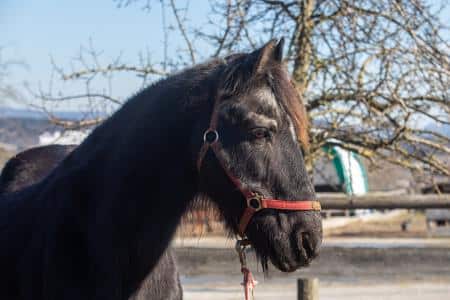
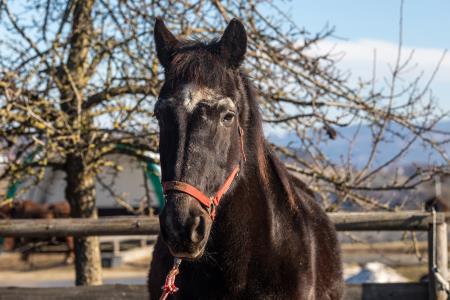
As diet is one of the most important factors for the functional diversity of the microbiota and can be easily adapted, it was decided to investigate how feeding management could favour the gut microbiota in older horses and the associated digestive and immune functions. This motivated the establishment of this project to promote healthy ageing in horses.
Aim: The aim of the project is to determine whether fibrolytic (crude fibre digestion) capacity and inflammatory ageing (inflammaging) develop according to age-related changes in the microbiota. This will include the following:
- Comparing the degradation efficiency of crude fibre in old versus adult horses,
- Investigating the relationships between microbiota composition and activity, crude fibre digestion and mild inflammation in old and adult horses,
- Identify relevant biomarkers that can be easily used to track age-related changes
- Compare different feeding regimes for older horses to determine the most appropriate one
To achieve these goals, three studies will be conducted in France from 2021 to 2023.
New findings: The results of the first study, which was conducted in the first half of 2022, are currently being analysed. This data will be available by the end of 2022.
Outlook: Based on the results on changes in microbiota, fibrolytic and immune function, horse owners will be provided with revised and science-based feeding recommendations. This aims to promote the health and well-being of the oldest horses, but also to optimise feed management to keep horses in the „senior category“ healthier.
Publication: This work will be presented through scientific communication tools (international conferences and peer-reviewed publications) and through popularisation articles for horse owners.
Project leader: Lab To Field, Institut Agro Dijon – UMR PAM, Prof. DVM, PhD, Veronique Julliand
Project name: Treatment of equine skin tumours with betulinic acid using transcutaneous application methods
Basis/starting point: Equine malignant melanoma (EMM) is one of the most common skin tumours in horses and occurs most frequently in white horses (white horses). Up to 80 % of grey horses over 15 years of age develop malignant melanoma. The tumours are mainly found on the tail rump, in the perianal area, on the genitals, eyelids, lip, parotid gland or air sacs. They show slow, displacing growth and tend to metastasise to the internal organs as they progress. The symptoms for the affected animals are initially of a mechanical nature (problems with defecation or urination, feed intake, eyelid closure, etc.), but can severely restrict the quality of life of the horses as the disease progresses and can also cause far-reaching problems due to metastasis.
There is currently no standard therapy for the treatment of EMM. At present, tumours are usually treated surgically or with chemotherapy. These treatment methods are sometimes successful for small tumours, but the prognosis for larger tumours is significantly worse. In addition, the administration of chemotherapeutic agents harbours risks for the treated animal, the treating veterinarians and the horse owners.
Aims: The aim of this study is to find a new, local treatment method that is effective, but also safe for the treated animal, the treating veterinarians and animal owners. In addition, the therapy method should be easy to perform and non-invasive.
Betulinic acid is a naturally occurring secondary plant substance extracted from the bark of birch and plane trees. Betulinic acid and the derivative NVX-207 inhibit the growth of melanoma cells and have anti-inflammatory, antiviral and wound-healing properties.
As both active ingredients have already produced promising results for the treatment of EMM in several studies, these active ingredients are being investigated further. To this end, the concentrations of the active ingredients in new microemulsion gels are being increased in order to better overcome the skin barrier and thus achieve higher concentrations of active ingredients in the skin.
Results/new findings: The substances to be analysed are first tested under laboratory conditions. This involves testing whether the active ingredients applied to the skin either dissolved in the microemulsion gel or with the help of a transdermal oxygen-assisted application method achieve sufficient concentrations in the skin. Initial results show that the desired active ingredient concentrations in the skin could be achieved with all tested substances and both tested application methods.
Outlook: The aim of this study is to successfully treat horses suffering from equine malignant melanoma with these newly developed treatment methods.
The evaluation is currently underway to decide which of the tested substances will be used on the affected horses. The treatment trial for the sick horses will be carried out at the rehabilitation centre for horses in Switzerland. Preparations for this are currently underway.
Project management: Dr med. vet., DVM-PhD Karina Klein, Prof. Dr med. vet. Jessika-M. V. Cavalleri
Melanomas in the area of the oral cleft; in the area of the parotid gland; in the perianal area and on the tail rump
© Photos: Paula Zscherpe
The aim of the research platform is intensive co-operation and exchange between Gut Aiderbichl and the Vet. Med. University of Vienna in the field of research into ethically relevant veterinary aspects of the human-horse relationship. In particular, the focus is on decision-making processes and their criteria as well as necessary therapy decisions in view of old and/or chronically ill animals. The interdisciplinary projects of the research platform approach the complex topic of the quality of life of horses from different perspectives in order to be able to support good decisions for the horses at Gut Aiderbichl and beyond.
Quality of life for old and chronically ill horses
Basis/starting point: Although quality of life has been used for many years as a decision-making tool for the treatment and euthanasia of animal patients, there is currently no universally accepted definition of equine quality of life, no consensus on the factors that contribute to equine quality of life, and no established methodology for its assessment.
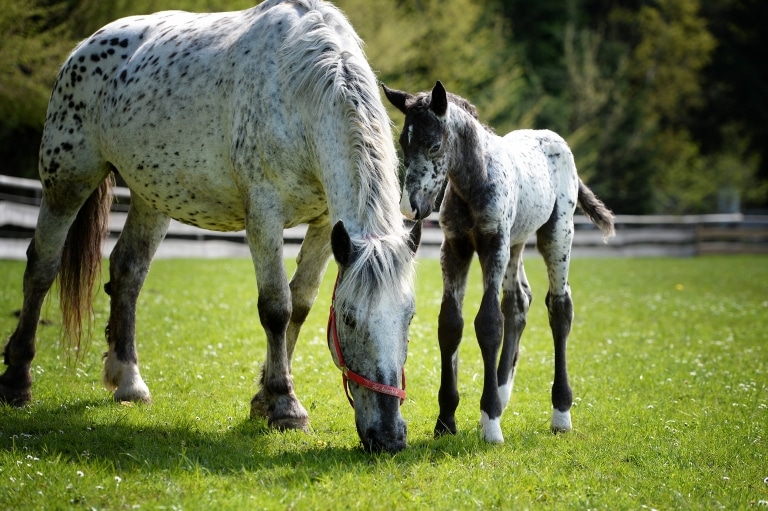
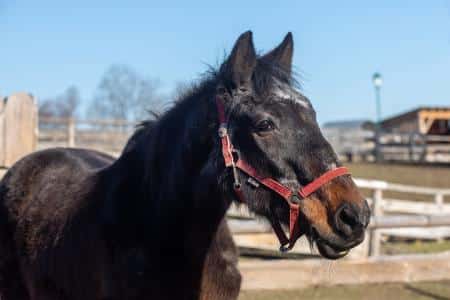
Aims: The aim of this project is to develop an examination scheme to assess the quality of life of horses and to make decisions regarding veterinary interventions in geriatric and/or chronically ill horses.
Results/New findings: The horses at Gut Aiderbichl are regularly examined over the course of the study. During each examination period, the horses are fitted with a wearable sensor for 5-10 days. The sensors show how much time the horses spend on various activities, such as eating, resting, lying down or exercising. During the examination period, the horses are also examined by a vet so that deviations in the measurement data can be linked to changes in health.
Outlook: Deviations in the measurement data, e.g. in eating times or lying times, or behavioural changes, changes in posture, as well as a visibly painful face can be an indication of (health) problems. The horses require a more detailed examination in order to find the cause of the deviation and to develop customised interventions, such as posture optimisation or medical therapy, to improve the horse’s well-being.
Publications: Auer U, Kelemen Z, Engl V, Jenner F. Activity Time Budgets-A Potential Tool to Monitor Equine Welfare? Animals (Basel). 2021 Mar 17;11(3):850. doi: 10.3390/ani11030850.
Kelemen Z, Grimm H, Long M, Auer U, Jenner F. Recumbency as an Equine Welfare Indicator in Geriatric Horses and Horses with Chronic Orthopaedic Disease. Animals (Basel). 2021 Nov 8;11(11):3189. doi: 10.3390/ani11113189.
Kelemen Z, Grimm H, Vogl C, Long M, Cavalleri JMV, Auer U, Jenner F. Equine Activity Time Budgets: The Effect of Housing and Management Conditions on Geriatric Horses and Horses with Chronic Orthopaedic Disease. Animals (Basel). 2021 Jun 23;11(7):1867. doi: 10.3390/ani11071867.
Project management: Hon.-Prof. Univ.-Prof. Dr Herwig Grimm, Dipl.ACVS Univ.-Prof Dr med.vet. Dipl.ECVS Jenner Florien
Ethics of end-of-life decisions for old and/or chronically ill horses
Basis/starting point: The simple question „How is my horse?“ poses major challenges. How can you put yourself in the horse’s shoes and how can you know that you are correct in your assessment of quality of life? The project deals with the quality of life of chronically ill and old horses against the background of increasing possibilities in veterinary medicine and the associated questions about the appropriateness of therapies at the end of a horse’s life.
Although quality of life is relevant as an important decision criterion for therapies and euthanasia, it is a concept without a clear definition and is also complex to assess in practice. In addition, there are usually several parties involved with different approaches and relationships to the horse, such as horse owners and veterinarians, who do not always agree on how best to proceed with a horse.
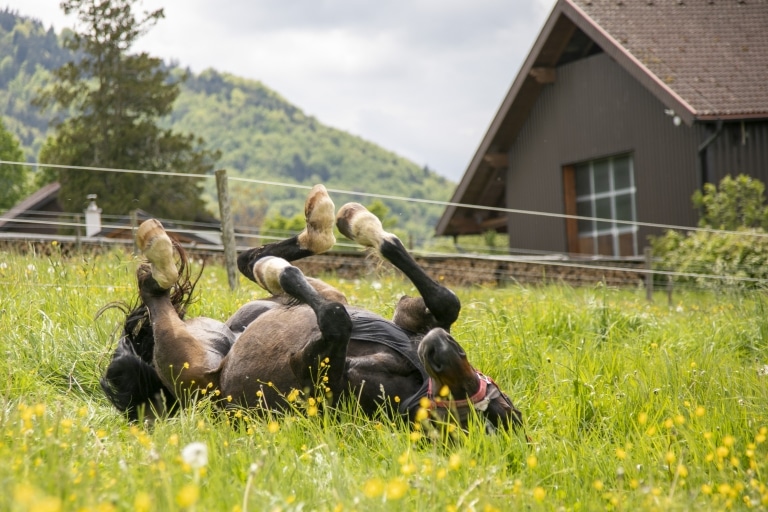
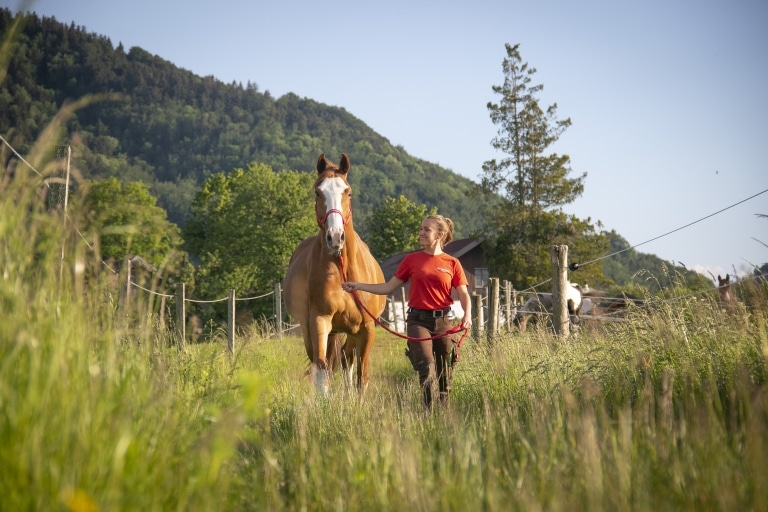
Objectives: Our project therefore addresses the question of what quality of life means in horses and how this concept can be applied in practice to make responsible decisions for chronically ill and old horses. What difficulties do those involved encounter in practice and how do they deal with them? And how can the different perspectives of those involved be brought together profitably to achieve good decisions for chronically ill and old horses?
Results/New findings: Seven focus group discussions were conducted against the background of an extensive literature review and are currently being analysed. In intensive discussions, horse owners, equine veterinarians, grooms, official veterinarians and farriers provided their expertise and experience on decisions for chronically ill and old horses and on the role of horses‘ quality of life in this context.
Outlook: We hope that this project will provide the best possible scientific basis to support the difficult decisions about therapies and euthanasia for chronically ill and old horses.
Publications:
Long, M., Jenner, F., Kelemen, K., Cavalleri J.-M., Auer, U., Grimm, H., 2022. 53. case discussions in a clinical ethics support service for equine medicine: a field report. In Transforming Food Systems, Proceedings of the EurSafe 2022, Edinburgh, Scotland, 7-9 September 2022; Bruce, D., Bruce, A., Eds; Wageningen Academic Publishers: Wageningen, The Netherlands; pp. 344-349. (https://www.wageningenacademic.com/doi/pdf/10.3920/978-90-8686-939-8_53)
Project management: Hon.-Prof. Univ.-Prof. Dr Herwig Grimm
Social contact and access to resources as indicators of well-being and quality of life in horses
Basis/starting point:: Social behaviour is both a cause and a consequence of equine welfare and quality of life. Since only close companions are tolerated for affiliative interactions within a horse’s personal space, while agonistic behaviour is indicated by an immediate increase in social distance after contact, closeness (and its duration) is a good indicator of social behavioural traits in horses.
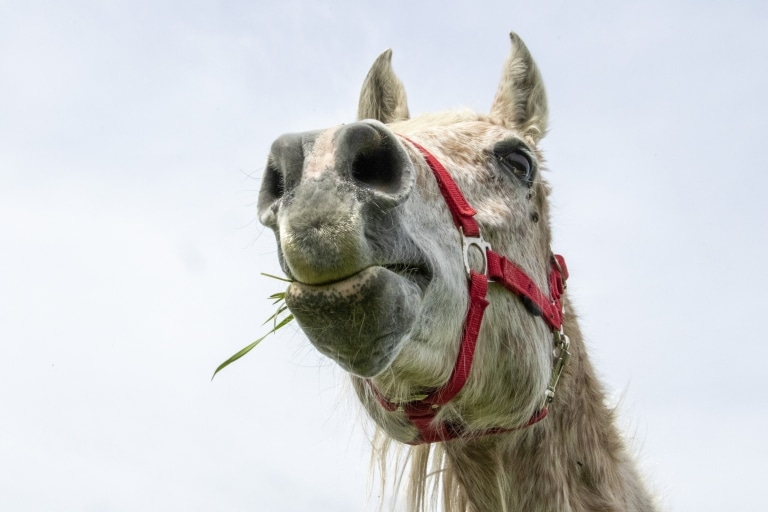
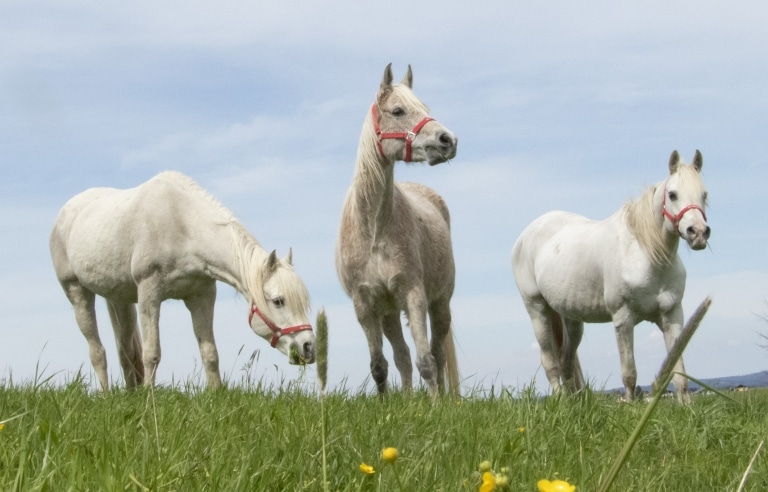
Objectives: This project aims to develop a new, complementary tool to assess the quality of life of horses in order to enable targeted interventions to improve horse husbandry and the quality of life of horses. This assessment is based on objective and quantifiable indicators of social relationships and interaction patterns, herd dynamics (access to resources such as feed, lying areas) and time budgets for eating, resting, activity and the discomfort score.
New findings: As part of the study, the horses at Gut Aiderbichl are regularly fitted with wearable sensors over a period of years:
- determine the spatial proximity between individual horses and the duration of proximity, which are characteristic of agonistic and affiliative behaviour;</li
- measure the access of individual horses to shared resources (food, lying areas);</li
- to compare the social behaviour and time budget of horses kept in individual stalls with paddock access in stable groups with horses kept in open stalls to determine the social contact network of horses under different housing conditions;
- to compare social behaviour, time budgets and discomfort scores between healthy young, healthy geriatric and chronically lame horses, as the effects of age and chronic lameness on equine social behaviour are unknown and this population is at higher risk of poor quality of life;</li
- to analyse the relationship between measurable social behaviour, time budgets and discomfort score with proxy assessment of quality of life;</li
Outlook: In this study, we establish and validate the use of proximity sensors to quantify social behaviour in horses and investigate the influence of different housing conditions and health status on the sociality and interaction network of horses. The inclusion of social criteria as a key component of quality of life assessment will facilitate targeted interventions in horses showing changes in their social behaviour. The same applies to herds with a high number of agonistic social interactions. This can help to improve animal husbandry, welfare and quality of life for horses.
Project management: Priv.Doz. OÄ Dr Ulrike Auer, Dipl.ACVS Univ.-Prof Dr med.vet. Dipl.ECVS Jenner Florien